Last month I was lucky enough to attend the annual Worlds of Flavor Conference up at the CIA in Napa. This annual conference is one of the best professional forums on flavor trends, and has also been described to me as, "the best food you'll eat all year." Every year a different, current trend in world cuisine is selected, and chefs and other experts from around the world are flown in to present their techniques and philosophies; topics in the last few years have ranged from Spain to the Mediterranean to street food. This year the theme was Japan, one of my very favorite cuisines (as I'm sure it is for most of the Bay Area), so I was thrilled to go.
Above, the sprawling, handsome CIA complex. It was a particularly lovely weekend to be in Napa: the rolling vine-covered hills looked especially picturesque in the golden autumn sun, and many of the visiting chefs commented on how much they appreciated the terroir of Napa valley.
Note: All photos with the Chinese watermark are mine and copyright Dessert First. All other photos are by Terrence McCarthy, courtesy of the Culinary Institute of America.
Over 50 chefs from Japan, ranging from kaiseki masters to tempura specialists, flew in to participate in the conference. A huge number of these chefs are starred Michelin chefs from Tokyo and Kyoto, making this event a real once-in-a-lifetime assemblage of talent. From top left, clockwise, just a few of the chefs: Yoshihiro Takahashi, Yoshihiro Murata, Masahiro Kurisu, and Hiro Sone.
Japan is famed for its gorgeous, refined aesthetic, and its food is no exception. There's not much that needs to be said here, as the presentation says it all. Many of the demonstrations highlighted the importance of presentation in Japanese cuisine, how the selection and placement of the various components is as important as the taste of the final dish. Japan is such a visual culture.
Steady, unerring precision. I found it interesting that many "modern" food concepts here, such as using local, seasonal products and simple preparations, have been part of Japanese cuisine for decades. Although a small country, Japan boasts thousands of microregions that have their own climate and local edibles, and every region has its own specialties. You can only find some ingredients in certain areas – and only at certain times of year. In Japan, seasonality is practically built into the cuisine, and has never been discarded. Fascinating that in the US we lost this sensibility and are just now regaining it.
The list of guest speakers was equally impressive. From top left, clockwise: Harold McGee, Ruth Reichl, Thomas Keller, Elizabeth Andoh.
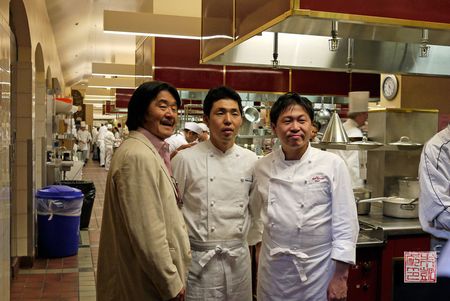
A surprise cameo from Iron Chef Sakai! Although he was not there to cook, chef Sakai nevertheless turned heads wherever he went and cheerfully posed for photographs with starstruck culinary students.
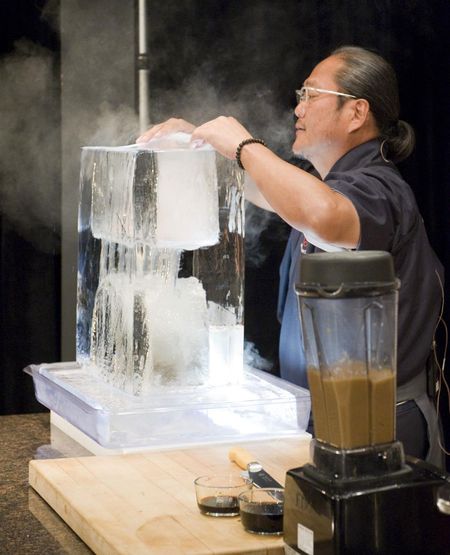
Chef Masaharu Morimoto, who clearly hasn't lost any of his flair for the dramatic from his Iron Chef days: he brought a smoker carved out of ice on stage (I think he was just showing off; I'm pretty sure this isn't found in his restaurant kitchens).
More food porn. Most of these dishes were prepared before our eyes on the demonstration stage – truly mesmerizing art. Many of the dishes shown here are prepared kaiseki style – kaiseki is the Japanese version of haute cuisine, the ultimate in showcasing ingredients of the season. Every element of the dish, from the garnish to the serving platter, are all chosen to convey a certain message – the beginning of fall, for example, or the harvest moon. It's like eating poetry.
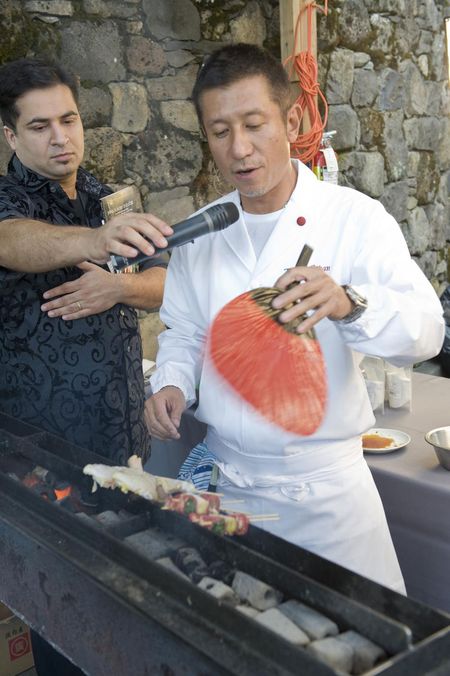
Chef Yatsunori Yashima, famous yakitori master and owner of three yakitori restaurants inTokyo and Fukuoka, demonstrating the cooking technique over bincho-tan, or charcoal. You must fan the meat constantly to keep the heat high and cook the meat evenly. As his fan stayed a constant blur over the skewers, chef mentioned that the temperature could reach up to 900 degrees. We ate some really good yakitori for lunch that day.
I have to mention, that of all the sessions I saw during the conference, the one standout that blew everyone away was a soba-making demonstration by Yoshinori Horii, an eighth-generation soba maker from Tokyo. I wish there were a video I could put up, because watching him turn flour and water into a perfect dough was like watching a dance – effortlessly graceful.
The speed with which he rolled and stretched out the dough into a flawless sheet, and then folded and cut it into noodles, was spellbinding. The only demo that received a standing ovation. For anyone who's ever made pasta, or any pastry dough, it was so amazing to watch a master in action.
The tasting hall, where all the conference attendees congregated at dinner to taste dishes prepared by the visiting chefs. Obviously everyone was looking forward to this! Listing all the wonderful things I tasted would take another post in itself – just look at the food porn photos at the top of this one for an idea!
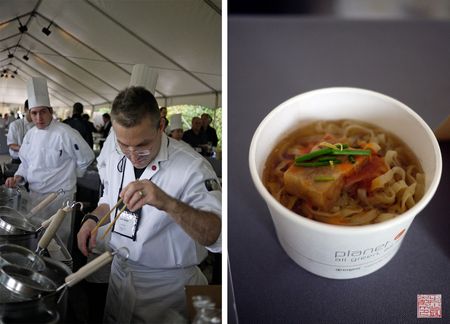
We also were served lunch from the chefs as well: I had more finely prepared sushi, meat, and noodles than I'd probably eaten in the last couple of months. Unexpectedly, I ate more pork belly in those two days than the entire rest of the year. One standout pork belly dish: Chef Ivan Orkin's ago dashi shoyu ramen. So. Good.
Chefs and culinary students of the CIA helping out during the lunch and dinner hours.
The CIA looks like a really fab place to learn how to cook!
So obviously I could go on and on about all the fabulous sushi and ramen, etc, but since this is a pastry blog (no booing, please!) I'll wrap up with a summary of the two pastry-oriented sessions I attended. Three pastry chefs from Japan, along with three American pastry chefs, demonstrated classic Japanese desserts as well as Western takes on Japanese flavors.
Chef Mitsuharu Kurokawa was one of the visiting pastry chefs and another person I was extremely impressed with. He is an eighteenth-generation confectionery maker and his family owns Toraya Confectionery, one of the oldest confection makers in Japan. Kurokawa heads up the Japanese branch of this shop in Paris. Not only was he extraordinarily skilled, but he also spoke English, and as the other two pastry chefs from Japan did not speak English, he also acted as their interpreter, describing their techniques as they demonstrated their craft. A very humble and talented young man.
This is one example of what Chef Kurokawa's family company makes: oshimono, or sugar colored and pressed into wooden molds to form intricately detailed candies. A mixture of sugar, potato starch, and mochi powder is combined with a little water and the combination quickly pressed into a mold before it dries. You must work quickly to pack in the sugar evenly. Otherwise, it'll fall apart when you unmold it.
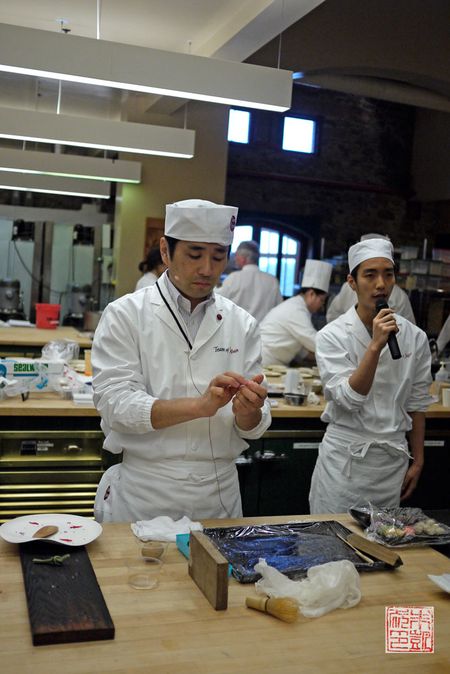
Chef Akihiko Saka is the Japanese equivalent of a pastry career changer: he worked for a mayonnaise company for years before deciding he wanted to go into confectionery. Today he owns his own pastry shop in Tokyo. Here he is shaping his own version of mochi into seasonal forms.
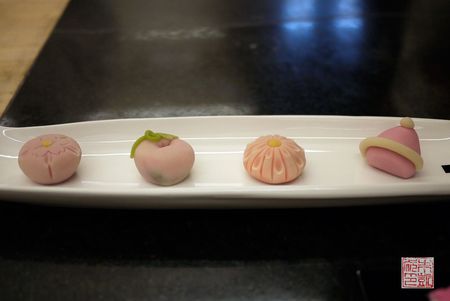
Here, Saka's creations: a cherry blossom for spring, a peach for summer, a chrysanthemum for fall, and a santa hat for winter. Japanese sweets, or wagashi, are strongly tied to the passing of the seasons, and different flavors and shapes of these sweets appear at different times of the year. The skill required to make these is impressive – Chef Saka made these in minutes, and Chef Durfee mentioned that he had trouble forming a chestnut, supposedly the simplest of shapes to make.
Chef Hirofumi Ohta, a second generation confectionery chef, works on carving his nerikiri, soft mochi-like sweets made of a sweet dough covering a red bean filling, into delicate flowers. You can see chefs Bill Yosses and Stephen Durfee watching from behind.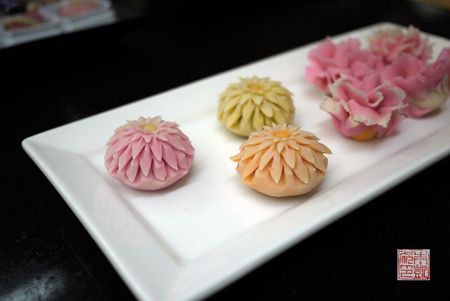
Ohta's chrysanthemums. The roses in the background are made from long ribbons of the same dough.
Local pastry chef Elizabeth Falkner also participated in the pastry workshop. Falkner has long been a champion for molecular gastromony and unusual flavors, so not surprising that her dessert, a sundae of red bean and genmaicha ice creams, yuzu fudge and soy caramel sauces, and frozen red bean "rain" was a perfect encapsulation of Japanese flavors meet American pastry.
Chef Durfee of the CIA did his own tribute to Japanese pastry with a melon parfait: a melon formed out of melon puree to echo the Japanese tradition of modeling sweets in the forms of fruits and flowers; atop an almond cake with royal icing cookie with melon balls.
All in all, these were three of the best food days I've enjoyed all year and I'm humbled by the opportunity to have seen so many masters of the craft up close and in action. And itching to get over to Japan so I can have some more of their food. I'll end with a recipe for passionfruit mochi, by pastry chef Bill Yosses – just a tiny little taste of Japan.
Passionfruit Mochi
adapted from recipe by Bill Yosses
340 Mochiko sweet rice flour
400 Passion fruit puree
320 grams sugar
40 grams glucose or corn syrup
Adzuki (red bean) filling
Combine all ingredients together in a microwaveable bowl.
Cover tightly with plastic wrap and microwave for about 5 to 6 minutes.
Scrape mochi onto a cutting board dusted with cornstarch.
DIvide into about 32 pieces. Roll each piece flat. Use a cookie cutter to cut round discs from each piece.
Place a small scoop of adzuki bean filling in the center of each disc. Pull dough around the filling and pinch to seal, forming a ball.
Freeze until ready to serve.
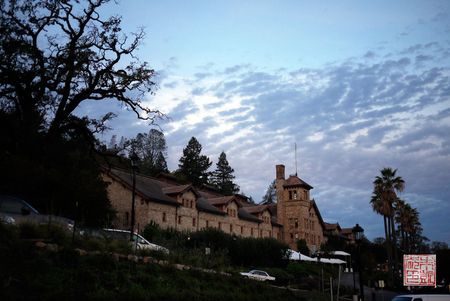
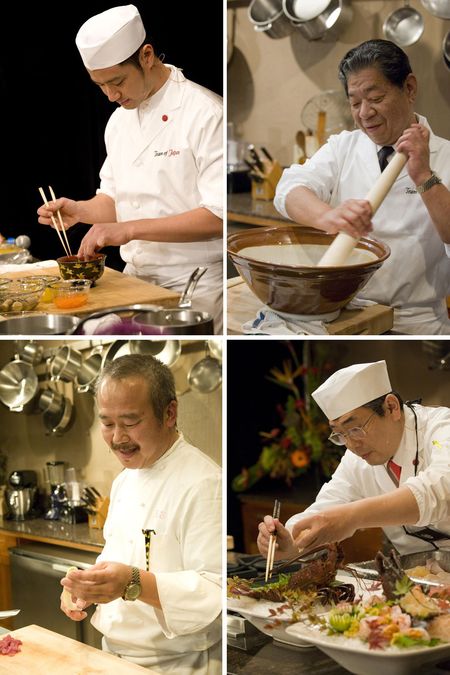
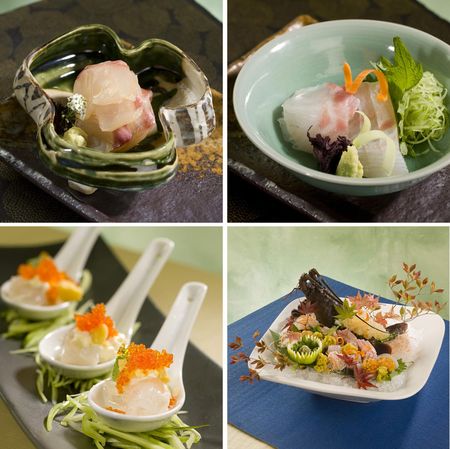
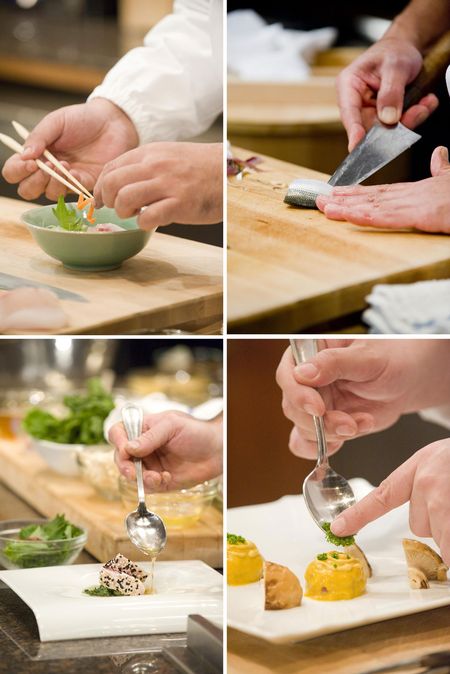
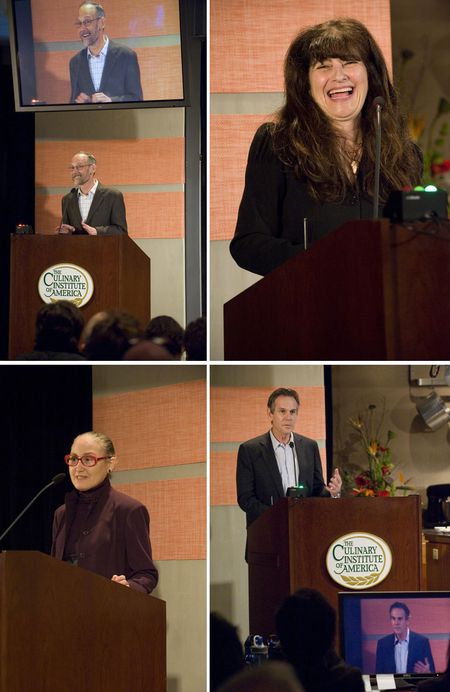
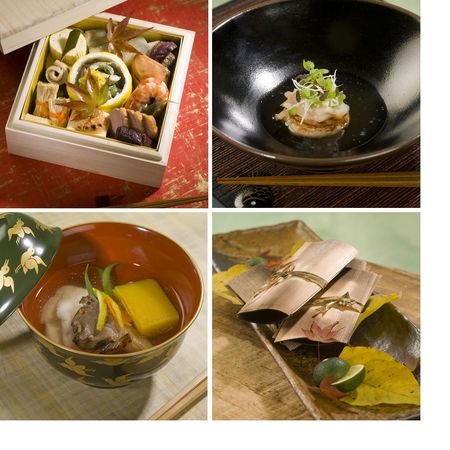
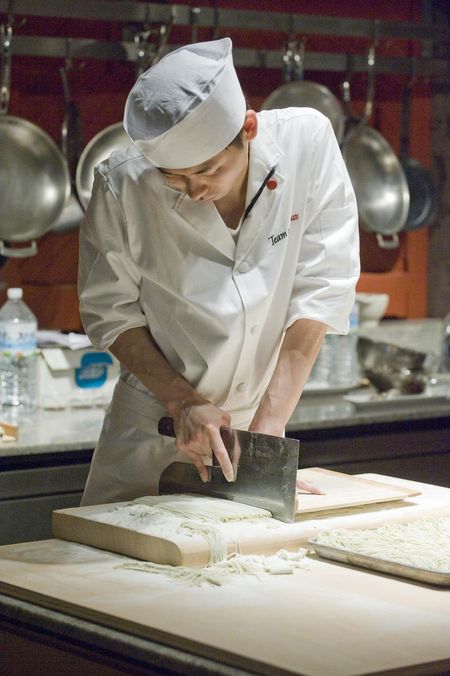
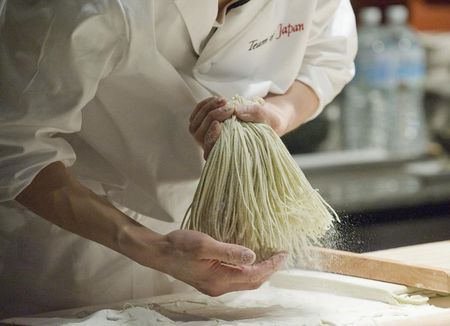
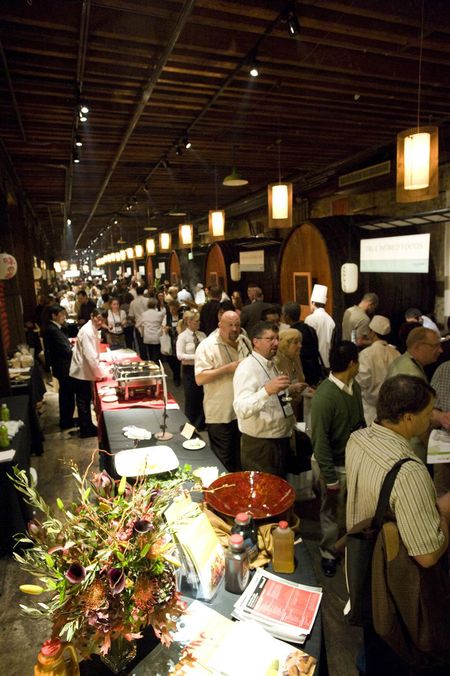
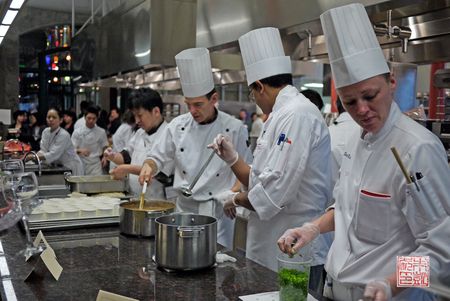
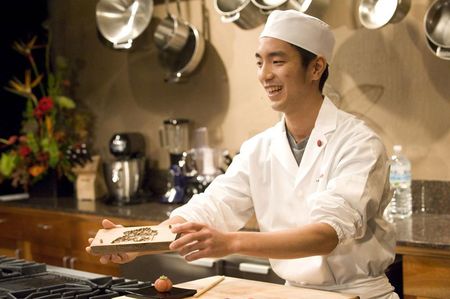
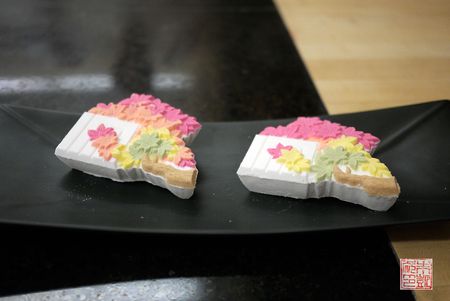
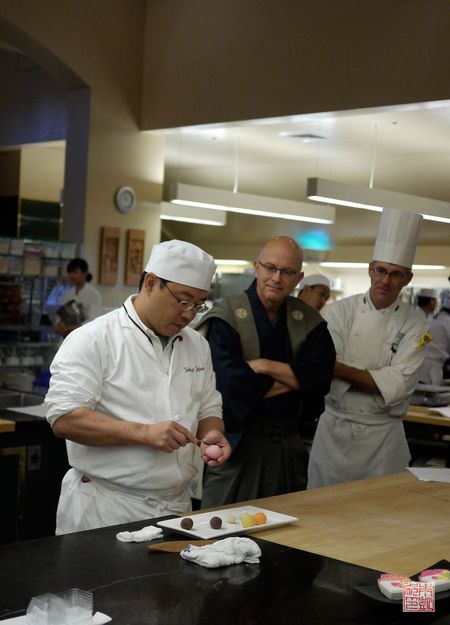
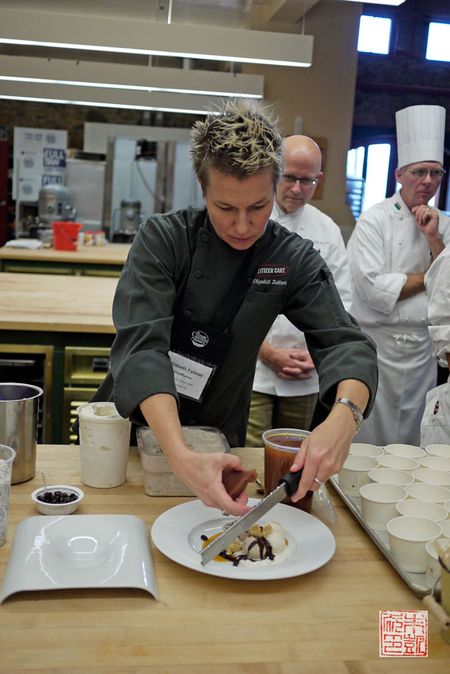
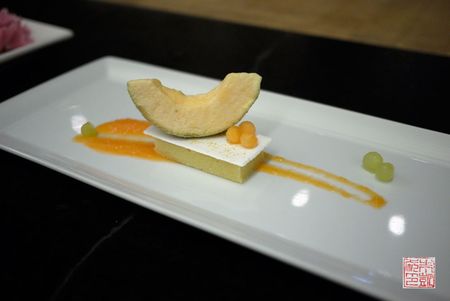
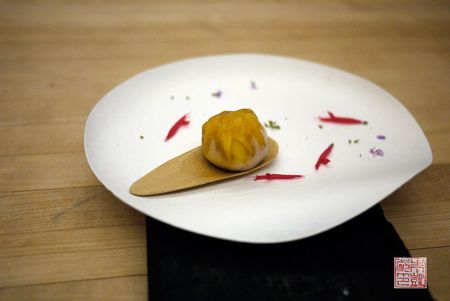
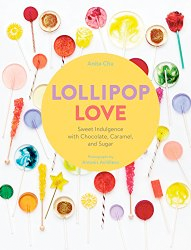

exciting event! such a wonderful opportunity.
Terrific recap. Wish I could’ve been there too! That passionfruit mochi recipe looks very interesting – what’s the texture like, served straight from the freezer?
What a fantastic post, thanks for sharing your experiences. They are very inspiring.
Freeze Dried Foods
Daily Bread
Food Storage
What a great opportunity Anita! Even though you weren’t able to get a video, you still captured the spellbinding nature of the soba doemonstration. Inspiring post. 🙂
Thank you for sharing these wonderful pictures from your exciting trip! I’m enjoying them a lot 🙂
They were are incredibly amazing! I wish I am a chef too. Thanks for sharing. Such a refreshing entry.
You were in my backyard, you were so close! Looks like you had fun and learned a lot!
The pictures are amazing (I’m literally drooling now).
I’m always amazed by how the Japanese cuisine is artistic and beautiful. Sure, it packs amazing flavors, but the aesthetics of it are breathtaking sometimes.
Thank you for a delightful read.
Itai Matos (TFIM)
How wonderful that you attended this event! I miss Japan and the food over there. Especially, Chef Sakai’s restaurant!
How wonderful that you attended this event! I love Japan and the food there! Especially, food from Chef Sakai’s restaurant!